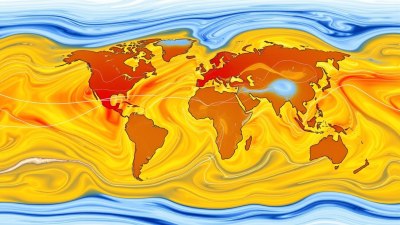Why the Sun Plays Hide and Seek All Day Long (And Always Wins)
Explore the fascinating reasons behind the sun's daily journey across the sky.

This image was created with the assistance of Freepik
The Sun, our star and the center of our solar system, has been a subject of awe and wonder throughout human history. Its visible presence in the sky, marked by its cyclical patterns, evokes a sense of rhythm in nature and is fundamental to life on Earth. But have you ever considered why it seems to play hide and seek all day long? In this article, we will delve into the reasons behind this celestial game, exploring the science, culture, and impact on our daily lives.
The Science Behind the Sun's Movement
The apparent motion of the Sun across our sky is primarily the result of Earth’s rotation on its axis. As our planet spins, different areas are exposed to the Sun, creating the cycle of day and night. This movement is consistent and predictable, leading to the daily journey of the Sun from east to west. Specifically, the Earth rotates approximately 15 degrees per hour, allowing us to witness the Sun rising, traversing the sky, and ultimately setting. This phenomenon is not only critical for our daily lives but also affects the fundamental processes of life, such as the circadian rhythms in humans and animals.
The Role of Atmospheric Conditions
Aside from Earth's rotation, the atmosphere plays a significant role in how we perceive the Sun throughout the day. During the early hours of the morning and later in the evening, sunlight must pass through a thicker layer of atmosphere, resulting in a scattering of shorter blue light waves. This scattering causes the stunning colors of sunrise and sunset, while also creating a visual illusion that the Sun is closer to the horizon than it actually is. Furthermore, varying weather conditions such as clouds, fog, and pollution can obscure our view of the Sun, making it appear to play hide and seek even more effectively. On overcast days, the Sun may seem to disappear entirely, only to re-emerge as the clouds shift or disperse.
Cultural Interpretations of the Sun's Path
Different cultures have attributed various meanings to the Sun's movement. Ancient civilizations, including the Egyptians and Mayans, built elaborate temples and structures aligned with the solar cycle, emphasizing their reverence for this celestial body. In myth, the Sun has frequently been personified, depicted as a powerful deity that governs the day. These cultural interpretations of the Sun's behavior have persisted across the ages, influencing art, literature, and spirituality. The notion of the Sun playing hide and seek serves as a metaphor for the cycles of life, death, and rebirth, drawing connections between the human experience and the natural world.
The Sun in Modern Science
In the realm of modern science, understanding the Sun's behavior extends beyond its mere appearances. Solar activity, including sunspots, solar flares, and coronal mass ejections, can significantly impact life on Earth. These phenomena are caused by the Sun's magnetic field and can influence satellite communications, navigation systems, and even power grids. Scientists consistently monitor solar activity to predict and mitigate the potential effects on technology and infrastructure. Consequently, the Sun's daily game of hide and seek transcends our visual experience and has tangible implications for modern life.
The Importance of the Sun's Cycle to Ecology
The Sun's presence influences not only weather and climate but also the ecology of our planet. Photosynthesis, the process by which green plants convert sunlight into energy, depends entirely on the Sun's rays. Through this remarkable process, plants release oxygen, maintain ecosystems, and contribute to the food chain. Furthermore, various organisms have adapted their behaviors, reproductive cycles, and migrations according to the Sun’s journey. For example, many birds migrate in relation to seasonal changes spurred by the Sun's position. In this sense, the Sun plays a pivotal role in the delicate balance of our ecological systems.
The Psychological Impact of Sunlight
The Sun's presence or absence can profoundly affect human psychology and mood. Research has shown that exposure to natural sunlight increases serotonin levels in the brain, contributing to improved mood and overall well-being. Conversely, a lack of sunlight, especially during the winter months, can lead to Seasonal Affective Disorder (SAD), a type of depression triggered by changes in light exposure. This psychological connection to sunlight emphasizes the Sun's role in our daily experiences and well-being. Artists and writers often draw inspiration from the Sun’s position in the sky, capturing its ability to evoke a wide range of emotions.
Climate Change and the Sun's Role
The Sun's energy is an integral part of the Earth’s climate system; however, human activities have created an unnaturally rapid change in our climate. The increase in greenhouse gases has led to an enhanced greenhouse effect, trapping more heat in our atmosphere. This situation can alter the patterns of solar radiation received on Earth, leading to unpredictable weather and climate patterns. Understanding the Sun's role in climate change is essential for developing sustainable practices and mitigating its impacts. As we delve deeper into the science, it becomes clear that while the Sun may seem to play hide and seek, its influence on our planet is ever-present and constant.
Observing Solar Phenomena
For those fascinated by the Sun, observing solar phenomena can be an awe-inspiring experience. Events such as solar eclipses, transits of Venus, and solar flares provide unique opportunities to witness the Sun's behavior. Educators often use these events as teaching moments, highlighting the importance of scientific inquiry and community engagement. Moreover, innovations in technology have allowed amateur astronomers to explore the Sun more closely than ever before, contributing to our understanding of solar activity and its effects on Earth.
The Sun and the Future of Humanity
As we look to the future, the Sun will continue to play a central role in discussions surrounding renewable energy and sustainable living. Harnessing solar energy through photovoltaics and solar thermal systems offers an opportunity to reduce our carbon footprint and transition to more sustainable energy sources. This shift not only addresses contemporary challenges such as climate change but also echoes humanity's timeless relationship with the Sun. By embracing the Sun as a renewable resource, we can forge a path toward a more sustainable future, one where the Sun no longer has to play hide and seek but is fully integrated into our lives.
Embracing the Dance of Light
The Sun's daily journey may appear to be one of hide and seek, but it is, in fact, a beautifully choreographed dance influenced by time, space, and our planet's unique characteristics. From its scientific explanations to its cultural significance and ecological impact, the Sun remains a pivotal figure in our lives. As we continue to explore its mysteries, let us also appreciate the light it brings—both literally and metaphorically. In our quest for knowledge, we are reminded that the Sun is not just a distant star; it is an integral part of our existence, illuminating our world in profound and intricate ways.











